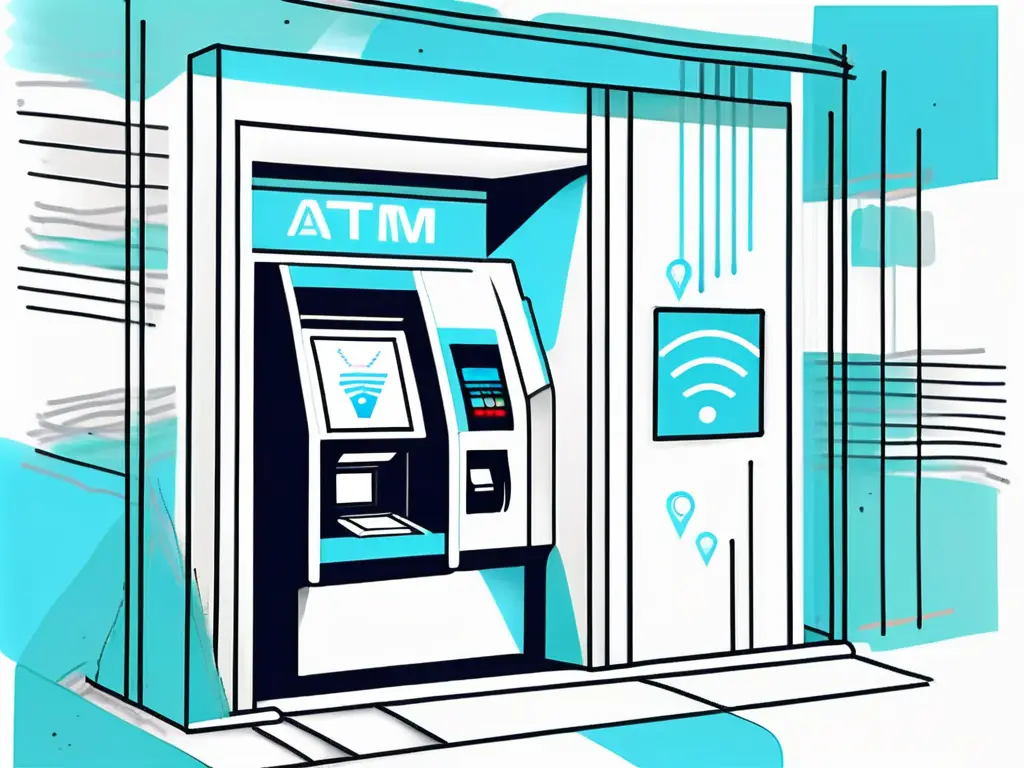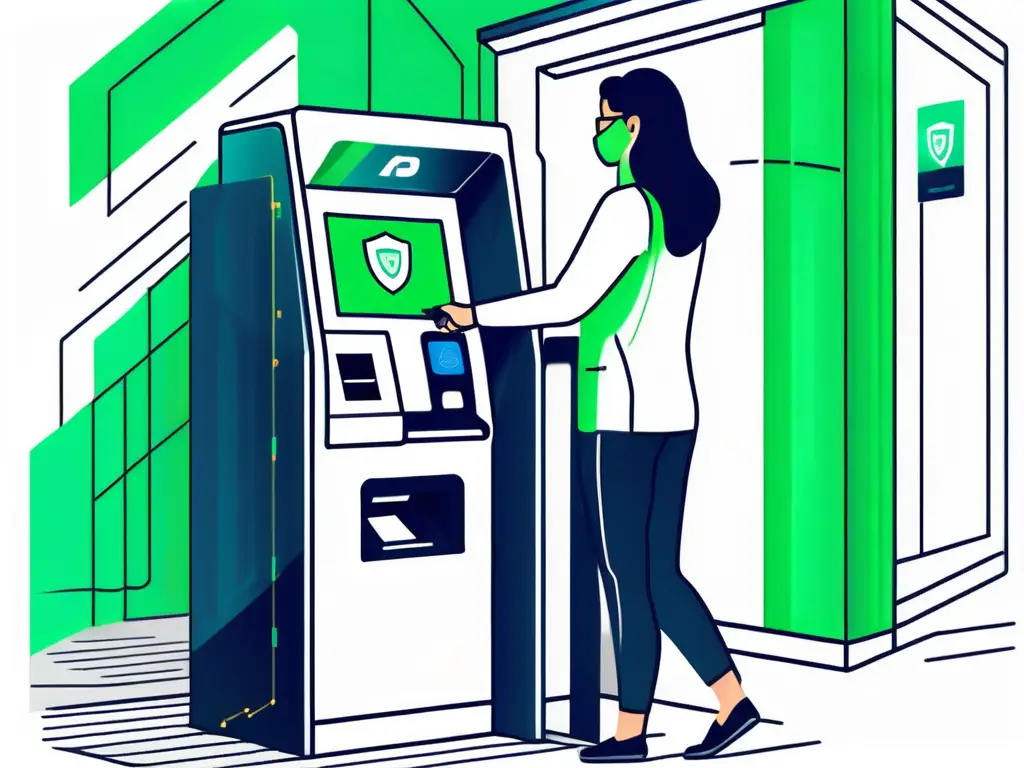In today’s digital age, convenience is key. From contactless payments to smart homes, technology has transformed the way we live. However, with every advancement comes the risk of exploitation. One such threat that has emerged in recent years is contactless ATM skimmers. These sophisticated devices pose a significant danger to consumers and financial institutions alike. To tackle this issue head-on, it is crucial to understand the concept of contactless ATM skimmers and the technology behind them.
Understanding the Concept of Contactless ATM Skimmers
The evolution of technology has led to the development of contactless skimming techniques. Gone are the days of traditional ATM skimmers that required physical contact with the card reader. Contactless ATM skimmers operate differently, leveraging wireless technology to capture sensitive card information without the user realizing it.
As technology advances, the world of cybercrime evolves in tandem. Contactless skimming represents a new frontier in ATM fraud, posing a significant threat to the security of financial transactions. Understanding the intricacies of these sophisticated techniques is crucial in safeguarding personal information and preventing unauthorized access to sensitive data.
The Technology Behind Contactless Skimming
At the heart of contactless skimming lies radio frequency identification (RFID) and near-field communication (NFC) technologies. These technologies allow data to be transmitted wirelessly between devices at close range. Skimming devices are designed to intercept and collect this data, which includes the cardholder’s name, card number, and expiration date.
RFID technology, commonly used in contactless payment cards and key fobs, enables quick and convenient transactions. However, this same convenience also presents opportunities for malicious actors to exploit system vulnerabilities. By leveraging NFC capabilities, criminals can surreptitiously capture sensitive information, paving the way for fraudulent activities and identity theft.
The Evolution of ATM Skimming Techniques
Over the years, ATM skimming techniques have become increasingly sophisticated. Criminals constantly find new ways to improve their methods, making detection even more challenging. From overlay devices that fit seamlessly over the card reader to hidden cameras capturing PIN input, contactless ATM skimmers have rapidly evolved to stay one step ahead of security measures.
With the rise of contactless payment technologies and the widespread adoption of RFID-enabled cards, contactless skimming attacks are on the rise. As financial institutions and law enforcement agencies work to combat this growing threat, consumers must remain vigilant and educate themselves on best practices for protecting their personal and financial information.
The Threat of Contactless ATM Skimmers
The threat posed by contactless ATM skimmers cannot be underestimated. Understanding how these devices work and their impact on consumers and banks is essential in protecting ourselves from falling victim to this increasingly prevalent form of fraud.

Contactless ATM skimmers represent a sophisticated evolution in the realm of financial fraud, posing a significant challenge to traditional security measures. As technology advances, so do the tactics employed by cybercriminals, making it crucial for individuals and financial institutions to stay vigilant and proactive in safeguarding sensitive information.
How Contactless Skimmers Work
When skimming technology first emerged, criminals would tamper with the physical card readers, but contactless skimmers have changed the game. Instead of tampering with the reader itself, these devices are hidden in close proximity to the ATM, such as within a false front panel. When a card is inserted, the skimmer collects the data wirelessly, enabling fraudsters to reproduce the card and make unauthorized transactions.
The stealthy nature of contactless skimmers makes them particularly insidious, as they can go undetected by unsuspecting individuals using ATMs for legitimate transactions. This covert method of data theft underscores the importance of heightened awareness and scrutiny when engaging with automated banking machines.
The Impact on Consumers and Banks
The consequences of falling victim to contactless skimming can be severe. For consumers, the unauthorized use of their payment cards can lead to financial loss, identity theft, and an invasive breach of privacy. Banks, on the other hand, face a loss of customer trust, financial liability, and the need to invest in more advanced security measures to combat this growing threat.
As the financial landscape continues to evolve in an increasingly digital direction, the prevalence of contactless skimmers is a stark reminder of the importance of adapting security protocols to mitigate risks effectively. Collaboration between industry stakeholders, law enforcement agencies, and cybersecurity experts is paramount in developing comprehensive strategies to counter the persistent threat posed by sophisticated fraudsters.
Identifying Contactless ATM Skimmers
Identifying whether a contactless skimmer has compromised an ATM is crucial in protecting ourselves. By familiarizing ourselves with the common signs of a skimmed ATM and understanding advanced detection techniques, we can stay one step ahead of criminals.
As technology advances, so do the methods used by criminals to steal sensitive information from unsuspecting ATM users. Contactless skimmers, capable of stealing data without physical contact, have become a prevalent threat. This makes it even more important for individuals to be vigilant and proactive in detecting any signs of tampering on ATMs.
Common Signs of a Skimmed ATM
Several signs to look out for may indicate the presence of a skimming device. These include loose or mismatched parts on the ATM, extra attachments on the card reader, or any visible tampering. Additionally, if the ATM feels unusually bulky or the keypad seems raised, it’s important to proceed cautiously.
Pay attention to any unusual behavior the ATM exhibits, such as error messages during transactions or unresponsive buttons. These could be subtle indicators of a skimming device at work, attempting to capture sensitive information without the user’s knowledge.
Advanced Detection Techniques
Advanced detection techniques are being developed to combat the increasing sophistication of contactless ATM skimmers. These include using specialized devices that detect hidden skimming devices, enhanced video surveillance, and improved encryption technology. Financial institutions can stay one step ahead of criminals by continually investing in detection methods.
Some financial institutions have implemented real-time monitoring systems to detect irregular ATM activity irregularities, triggering immediate alerts for further investigation. This proactive approach not only helps in identifying potential skimming attempts promptly but also aids in preventing widespread financial losses for both the institution and its customers.
Protecting Yourself from Contactless ATM Skimmers
While contactless ATM skimmers pose a significant threat, there are various steps we can take to protect ourselves from falling victim to this type of fraudulent activity.

One important aspect to consider is the physical appearance of the ATM itself. Before inserting your card, take a moment to inspect the card reader and the area around the PIN pad. Look for unusual devices, loose parts, or anything that seems out of place. Criminals often install skimming devices designed to blend in seamlessly with the ATM, so being observant can help you detect potential threats.
Best Practices for Safe ATM Usage
When using an ATM, it is essential to remain vigilant. Avoid using ATMs in isolated or poorly lit areas, as criminals often target these. Additionally, cover the keypad when entering your PIN to prevent hidden cameras from capturing your personal information. Finally, regularly monitor your bank statements and report any suspicious activity immediately.
Another proactive step you can take is to set up transaction alerts on your mobile device. Many banks offer this service, which notifies you of any activity on your account in real-time. If you receive an alert for a transaction you did not authorize, you can quickly contact your bank to report the issue and prevent further unauthorized access to your funds.
Security Measures to Consider
Financial institutions have a responsibility to safeguard their customers’ funds. Security measures like chip-enabled cards, two-factor authentication, and transaction monitoring systems can significantly reduce the risk of contactless skimming. By staying informed and choosing banks that prioritize customer safety, we can actively contribute to a safer banking experience.
Using ATMs located within bank branches is also advisable, as these are typically more secure and less likely to have been tampered with. If you notice anything suspicious or unusual about an ATM, such as a card slot that looks different from the others or a keypad that feels loose, trust your instincts and find another machine to use. Remember, taking a few extra moments to ensure your safety can go a long way in protecting your financial information from potential threats.
The Role of Banks and Law Enforcement
When it comes to combating contactless ATM skimmers, a collaborative effort between financial institutions and law enforcement is vital. By working together, preventive measures can be put in place, and swift action can be taken against skimming fraudsters.
In addition to the collaboration between banks and law enforcement, another crucial aspect in the fight against contactless ATM skimmers is public awareness. Educating consumers about the risks of skimming and how to spot suspicious activities at ATMs can greatly reduce the success rate of fraudsters. This proactive approach empowers individuals to protect themselves and their financial information.
Preventive Measures by Financial Institutions
Recognizing the severity of the threat posed by contactless ATM skimmers, financial institutions have taken steps to protect their customers. These measures include routine ATM inspections, staff training on skimming detection, and the implementation of robust security protocols. Furthermore, banks are actively investing in research and development to stay ahead of emerging skimming techniques.
Some financial institutions have introduced advanced technologies such as biometric authentication and real-time transaction monitoring to enhance security measures. These innovative solutions safeguard customers’ funds and provide peace of mind in an increasingly digital banking landscape.
Legal Consequences for Skimming Fraudsters
To deter potential skimming fraudsters, law enforcement agencies are cracking down on skimming operations. With the implementation of stricter penalties and dedicated task forces, criminals involved in contactless ATM skimming can face significant legal consequences. By targeting the source, we can help disrupt the skimming ecosystem and protect unsuspecting consumers.
International cooperation among law enforcement agencies has become essential in combating cross-border skimming syndicates. By sharing intelligence and coordinating efforts globally, authorities can track down and apprehend perpetrators operating across multiple jurisdictions. This collaborative approach not only strengthens the enforcement of anti-skimming laws but also sends a clear message that financial crimes will not go unpunished.
The Future of ATM Security
As technology continues to advance, the future of ATM security holds promise. Industry experts are continuously researching and developing innovative solutions to combat contactless skimming and ensure the safety of consumers’ financial transactions.

Technological Innovations to Combat Skimming
Advancements in ATM security technology are focused on creating a more secure and seamless experience for users. From biometric authentication methods, such as fingerprint or facial recognition, to artificial intelligence-powered fraud detection algorithms, the future holds great potential in mitigating the risks associated with contactless ATM skimmers.
One exciting technological innovation that is gaining traction is the use of iris recognition. By scanning the unique patterns in a person’s iris, ATM machines can authenticate users with an unprecedented level of accuracy. This not only adds an extra layer of security but also eliminates the need for physical contact, reducing the risk of skimming attempts.
Another area of research is the development of ATM machines equipped with advanced sensors and machine learning algorithms. These sensors can detect any abnormal behavior around the ATM, such as the presence of hidden cameras or tampering with the card slot. The machine learning algorithms analyze the data collected by the sensors in real-time, allowing the ATM to identify and respond to potential skimming attempts immediately.
The Shift Towards Digital Banking
With the increasing prevalence of digital banking, the reliance on traditional ATMs may decrease over time. As more financial transactions are conducted online, the risks posed by contactless ATM skimmers may be minimized. However, it remains essential for banks to remain proactive in developing robust security measures that protect both physical and digital channels.
Financial institutions are investing heavily in secure mobile banking applications that offer a wide range of services, including ATM withdrawals. These applications utilize multi-factor authentication, encryption, and secure communication protocols to ensure the confidentiality and integrity of transactions. By leveraging the power of smartphones and biometric authentication, users can securely withdraw cash without the need for physical ATMs.
Furthermore, the rise of blockchain technology is also expected to have a significant impact on ATM security. Blockchain, a decentralized and tamper-proof ledger, can provide an additional layer of security by recording and verifying every transaction made through an ATM. This technology ensures that every transaction is transparent and cannot be altered, reducing the risk of fraudulent activities.
Conclusion
The future of ATM security is filled with exciting possibilities. Technological innovations, such as iris recognition and advanced sensors, pave the way for a more secure and convenient banking experience. Additionally, the shift towards digital banking and the adoption of blockchain technology are expected to further enhance ATM security. By staying at the forefront of these advancements, financial institutions can ensure the safety and trust of their customers in an increasingly digital world.
As the landscape of ATM security evolves, so does the sophistication of cyber threats like contactless ATM skimmers. Blue Goat Cyber understands the critical importance of staying ahead of these threats to protect your business’s financial transactions and customer trust. With our comprehensive cybersecurity services, including penetration testing and compliance adherence, we are dedicated to fortifying your defenses against the most advanced cyber threats. Don’t let your guard down in the face of emerging risks. Contact us today for cybersecurity help and partner with a Veteran-Owned leader in cybersecurity. Let Blue Goat Cyber be your ally in the digital age, ensuring your assets remain secure and your operations uninterrupted.
